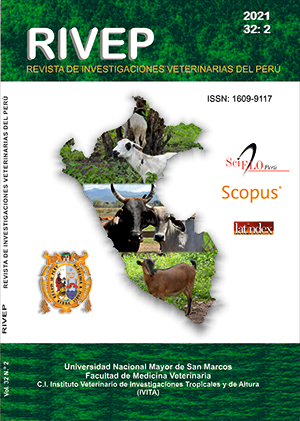Evolution of dactilogiroses (monogeneans) in gills of tambaqui fry (Colossoma macropomum) in two rearing aquatic media: artificial and seminatural
DOI:
https://doi.org/10.15381/rivep.v32i2.20015Keywords:
monogeneans, gills, tambaqui, fingerlings, aquatic environments, indigenous communitiesAbstract
The aim of this study was to determine the evolution of infestation by monogeneans of the Dactylogiridae family in gills of tambaqui fry (Colossoma macropomum) raised in cages in an artificial and semi-natural aquatic environment. In total, 120 45-day-old fingerlings were evaluated with an average weight of 3.05 + 0.58 g, and an average total length of 5.23 + 0.51 cm. The fish were distributed in two floating cages (60 fingerlings per cage), the first located in an earthen pond in a semi-intensive breeding farm (artificial environment), and the second in a reservoir (semi-natural environment). Both groups received a similar diet. The qualitative degrees of infestation considered were mild, moderate and severe, according to the number of monogeneans parasites found in the gill sections evaluated by direct microscopy. The fingerlings were free of the parasitic infestation at the beginning of the experiment, later 12 specimens were evaluated per group at 15, 30, 45, 60 and 90 days. At day 15, the infestation increased to a mild degree in the semi-natural environment and continued as negative in the artificial environment; later on they became mild in both media, until the end of the experiment, with no significant difference between degrees of infestation in both groups. It is concluded that both aquatic environments do not represent a risk for the development of moderate or severe infestations by monogeneans in gills that affect populations of tambaqui fry.
Downloads
Downloads
Published
Issue
Section
License
Copyright (c) 2021 Juan Rondón E., César Villanueva C., Cesar Gavidia C, Víctor Puicón N.

This work is licensed under a Creative Commons Attribution 4.0 International License.
AUTHORS RETAIN THEIR RIGHTS:
a. Authors retain their trade mark rights and patent, and also on any process or procedure described in the article.
b. Authors retain their right to share, copy, distribute, perform and publicly communicate their article (eg, to place their article in an institutional repository or publish it in a book), with an acknowledgment of its initial publication in the Revista de Investigaciones Veterinarias del Perú (RIVEP).
c. Authors retain theirs right to make a subsequent publication of their work, to use the article or any part thereof (eg a compilation of his papers, lecture notes, thesis, or a book), always indicating the source of publication (the originator of the work, journal, volume, number and date).










